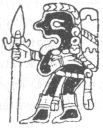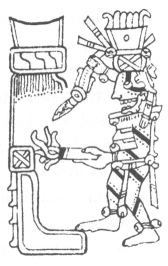
Sacred Texts Native American Maya Index Previous Next
Buy this Book at Amazon.com

Yucatan Before and After the Conquest, by Diego de Landa, tr. William Gates, [1937], at sacred-texts.com
They had offensive and defensive arms. The offensive were bows and arrows carried in their quivers, tipped with flints and very sharp fishes’ teeth, which they shot with great skill and force. The bows were of a beautiful yellowish wood, marvelously strong and more straight than curved, with cords of their hemp fibres. The length of the bow is always somewhat less than that of the one who carries it. The arrows are made of reeds that grow in the lagoons, and more than five palms long, in which is fixed a piece of thin wood, very strong, in which again is fastened the flint. They do not know or use poisons, though from no lack of them. They had
 |
 |
 |
For defense they had shields made of split and woven reeds, and covered with deer hide. They wore protective jackets of cotton, quilted in double thicknesses, * which were very strong. Some of the chiefs and captains wore helmets of wood, but these were not common. With these arms they went to war, adorned with feathers, and with skins of tigers and lions, when they possessed them. They had two captains, one perpetual and hereditary, the other elected for three years with a great deal of ceremony. This latter was selected to
 |
 |
This captain was called nacon; during these three years he was forbidden to hold converse with women, even with his wife, or to eat met. They held him in great respect, and supplied him with fish and iguanas, which are a sort of edible lizards; during this period he must not become drunk, and
the vessels and household articles for his use were kept apart; he was not served by a woman, and mingled little with the townsfolk.
 |
The three years passed as stated. These two captains arranged matters for wars, and put things in their order. In each district there were men chosen as the soldiery, and when the occasion came they presented themselves with their arms; these were called the holcánes, and if there were not enough of them, others were collected; they were then given instructions and divided. Marching led by a lofty banner they set out from the town in complete silence, and then taking their enemies by surprise, fell on them with great cries and fierceness.
On the roads and passages the enemy set defenses manned by archers, barricades of stakes and trees, and more often of stone. After a victory they cut off the jawbones from the dead, and hung them clean of flesh on their arms. In these wars they made great offerings of the spoils, and if they captured some renowned man they promptly sacrificed him, not to leave alive those who could later inflict injury upon them. The rest became captives of war in the power of those who took them.
These holcánes received no pay except in time of war, and then they were given certain money by the captains, but not much, because it came from their own funds; or if they lacked the needful, the town helped them. The town also supplied their food, which the women prepared for them; this they carried on their backs for the lack of animals, and thus the wars were of short duration. After the war the soldiers harassed the people in the districts greatly, under color of the war, while this lasted, requiring services and gifts; if any of them succeeded in killing some captain or chief he was greatly honored and feted.
50:* Landa here again makes the curious mistake before noted, of stating that they wore strong quilted coats of cotton and salt, in two layers. (See page 16.)
50:† The illustration of a copper axe on the preceding page is from the Landa manuscript itself. The axes in the margin above are from Aztec and shown to have been of copper both by the p. 51 distinctive color, and place-names elsewhere. The three lower figures are all from the Madrid Maya codex, showing a warrior with hulché, or throwing stick, and spears; the god Ekchuah with knapsack and long lance, and the war-god putting fire and sword to a building.